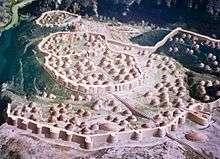Copper Age state societies
The Chalcolithic or Copper Age is the transitional period between the Neolithic and the Bronze Age.[1] It is taken to begin around the mid-5th millennium BC, and ends with the beginning of the Bronze Age proper, in the late 4th to 3rd millennium BC, depending on the region.
| Chalcolithic Eneolithic, Aeneolithic, or Copper Age |
|---|
|
↑ Stone Age ↑ Neolithic |
|
West Asia
|
|
Metallurgy, Wheel, Domestication of the horse |
|
↓ Bronze Age ↓ Iron Age |

The Chalcolithic is part of prehistory, but based on archaeological evidence, the emergence of the first state societies can be inferred, notably in the Fertile Crescent (Sumer, predynastic Egypt, Protominoan Crete), with late Neolithic societies of comparable complexity emerging in the Indus Valley (Mehrgarh) and in China.
The development of states—large-scale, populous, politically centralized, and socially stratified polities/societies governed by powerful rulers—marks one of the major milestones in the evolution of human societies. Archaeologists often distinguish between primary (or pristine) states and secondary states. Primary states evolved independently through largely internal developmental processes rather than through the influence of any other pre-existing state.
The earliest known primary states appeared in Mesopotamia c. 3700 BC, in Egypt c. 3300 BC, in the Indus Valley c. 3300 BC, and in China c. 1600 BC.
List of known polities
| City | period |
|---|---|
| Bad-tibira | 5000 BC to 2300 BC |
| Çatalhöyük | 6700 BC to 5700 BC |
| Ebla | 3500 BC to 1600 BC |
| Eridu | 5400 BC to 2050 BC |
| Girsu | 5000 to 2100 BC |
| Heliopolis (Lower Egypt) | 3500 BC to 1st century BC |
| Isin | 3500 to 2100 BC |
| Jericho | Neolithic (first settlement) to 1400 BC |
| Kish | 4000 to 2300 BC |
| Lagash | 4000 to 2250 BC |
| Laish | 4500 to 1350 BC |
| Mari | 5000 to 1759 BC |
| Mehrgarh | 5500 to 2500 BC |
| Nekhen (Upper Egypt) | 3500 BC to Ptolemaic Dynasty |
| Nippur | 5000 to 2450 BC |
| Susa | 4200 to 2330 BC |
| Rakhigarhi | 6500 BC to 1900 BC |
| Ugarit | 6000 BC to 1190 BC |
| Ur | 4000 to 2000 BC |
| Uruk | 4000 to 3100 BC |
References
- The New Oxford Dictionary of English (1998) ISBN 0-19-861263-X, p. 301: "Chalcolithic /,kælkəl'lɪθɪk/ adjective Archaeology of, relating to, or denoting a period in the 4th and 3rd millennium BCE, chiefly in the Near East and SE Europe, during which some weapons and tools were made of copper. This period was still largely Neolithic in character. Also called Eneolithic... Also called Copper Age - Origin early 20th cent.: from Greek khalkos 'copper' + lithos 'stone' + -ic".